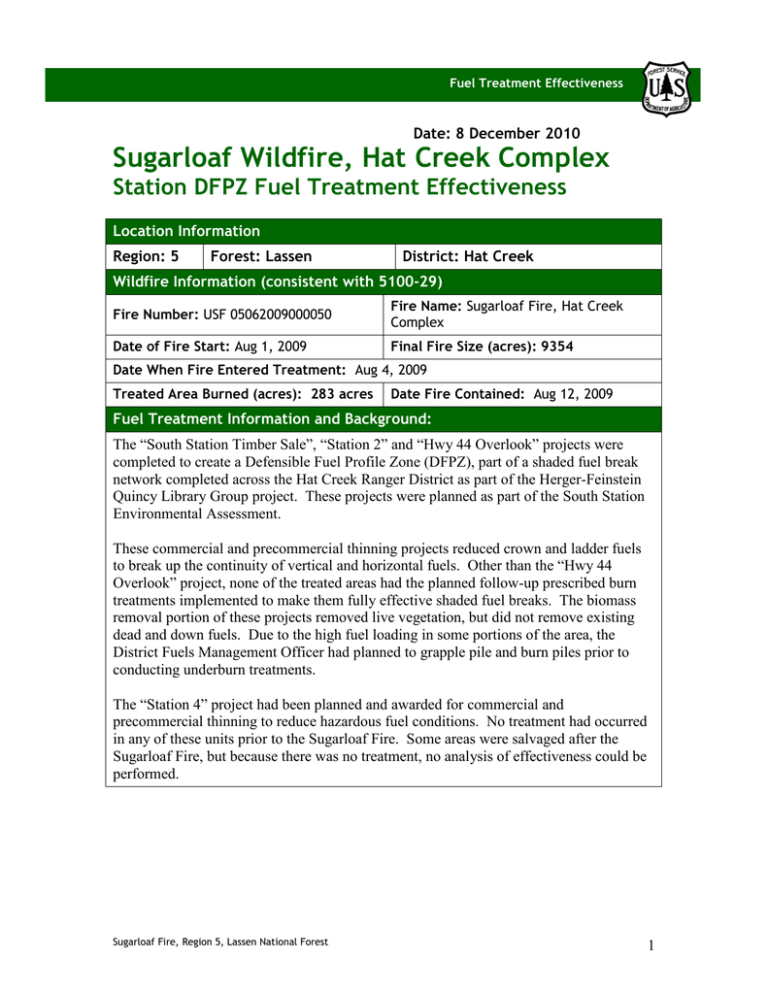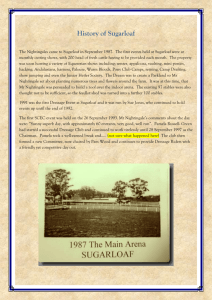Sugarloaf Wildfire, Hat Creek Complex Station DFPZ Fuel Treatment Effectiveness
advertisement

Fuel Treatment Effectiveness Date: 8 December 2010 Sugarloaf Wildfire, Hat Creek Complex Station DFPZ Fuel Treatment Effectiveness Location Information Region: 5 Forest: Lassen District: Hat Creek Wildfire Information (consistent with 5100-29) Fire Number: USF 05062009000050 Fire Name: Sugarloaf Fire, Hat Creek Complex Date of Fire Start: Aug 1, 2009 Final Fire Size (acres): 9354 Date When Fire Entered Treatment: Aug 4, 2009 Treated Area Burned (acres): 283 acres Date Fire Contained: Aug 12, 2009 Fuel Treatment Information and Background: The “South Station Timber Sale”, “Station 2” and “Hwy 44 Overlook” projects were completed to create a Defensible Fuel Profile Zone (DFPZ), part of a shaded fuel break network completed across the Hat Creek Ranger District as part of the Herger-Feinstein Quincy Library Group project. These projects were planned as part of the South Station Environmental Assessment. These commercial and precommercial thinning projects reduced crown and ladder fuels to break up the continuity of vertical and horizontal fuels. Other than the “Hwy 44 Overlook” project, none of the treated areas had the planned follow-up prescribed burn treatments implemented to make them fully effective shaded fuel breaks. The biomass removal portion of these projects removed live vegetation, but did not remove existing dead and down fuels. Due to the high fuel loading in some portions of the area, the District Fuels Management Officer had planned to grapple pile and burn piles prior to conducting underburn treatments. The “Station 4” project had been planned and awarded for commercial and precommercial thinning to reduce hazardous fuel conditions. No treatment had occurred in any of these units prior to the Sugarloaf Fire. Some areas were salvaged after the Sugarloaf Fire, but because there was no treatment, no analysis of effectiveness could be performed. Sugarloaf Fire, Region 5, Lassen National Forest 1 Fuel Treatment Effectiveness Figure 1. Map of the Sugarloaf fire and completed HFQLG projects in the vicinity. Sugarloaf Fire, Region 5, Lassen National Forest 2 Fuel Treatment Effectiveness Treatment Type and Acres FACTS subunit ID 050653 T031000003 000 Station 2 Project 050653 T032000013 000 South Station Timber Sale U-15 050653 F032000004 000 Hwy 44 Overlook 050653 T032000017 000 Station 4 Project 050653 T032000019 000 Station 4 Project 050653 T032000015 000 Station 4 Project Treatment Prescription, date completed and total acres Commercial Thinning and Biomass Removal June – August 2008 1523 acres Commercial Thinning Sept 2008 49 acres Precommercial Thinning, Piling, Burn Piles Jan 2005 53 acres Commercial Thinning and Biomass Removal Planned, but untreated 112 acres Commercial Thinning and Biomass Removal Planned, but untreated 92 acres Commercial Thinning and Biomass Removal Planned, but untreated 66 acres Acres overlap with Sugarloaf Fire 211 acres 19 acres 53 acres 59 acres 14 acres 22 acres Narrative of Fire Interaction with Fuel Treatment The Sugarloaf Fire was a lightning caused fire that started on Sugarloaf Mountain, approximately 2 miles to the west of the Station treatment area on August 1, 2009. Initially there were two fires that started on Sugarloaf Mountain, one near the top and the other one mid-slope (found on August 2), that later merged together. The Sugarloaf fire was first managed by local initial attack resources as a Type 3 Incident until the incident management team arrived to manage the Hat Creek Complex. The Sugarloaf Fire was part of a large scale lightning event which showered the Lassen National Forest in new starts. The Hat Creek Ranger District alone had detected over 37 new starts, the Sugarloaf Fire included. Resources on the forest had been depleted, communications limited at best, logistics overburdened, and structures threatened throughout the complex. Due to an abundance of fire activity on the forest, minimal resources were available in the suppression effort of the Sugarloaf Fire. On August 2, Sugarloaf fire was considered a low priority fire and resources on the district were committed to other fires in the Hat Creek Complex. The Sugarloaf fire grew upslope through the night and on the afternoon of August 3 the prevailing winds pushed the fire towards the community of Old Station. Sugarloaf Fire, Region 5, Lassen National Forest 3 Fuel Treatment Effectiveness Initial attack to protect Old Station was done with several engines, the Old Station volunteers, one bull dozer, and 4 hot shot crews. On August 4 the fire burned up the Hat Creek Rim rapidly and with high intensity in untreated areas and continued to burn into the southeastern portion of this wildfire area into the commercially thinned units with heavy surface fuels present. Surface fuels had not yet been treated and the result was a high intensity fire that burned out of control, through a quarter mile-wide partially constructed fuel reduction project, and killed the existing trees. Furthermore, fire fighters were unable to stop the forward progression of the fire even though the commercially thinned area was a quarter mile in width in some locations. The lesson learned here is that it is critical that surface fuels are treated in order to have a successful defensible fuel profile zone. Further north in the vicinity of the Hat Creek Rim overlook north towards Plum Valley Reservoir the fire did not burn up the Hat Creek escarpment with much intensity. The vegetation below the rim in this area was largely brush in rocky terrain and the fire arrived in the treated area without a large head of steam behind it. The treatment in this area included precommercial thinning, piling, and burning piles. The fuel loading in this area was much lower and the resulting fire was low intensity with low flame lengths and a low rate of spread. The fire did not cause much damage in this area. Weather observations are included in the table below, according to the Ladder Butte RAWS Station in Redding. Conditions When Fire Entered Treatment Date and Source of Observations: Aug 4, 2009, 13:18 hrs Ladder Butte Raws Station ERC (value and percentile): Windspeed and Direction: 9mph @ SSE degrees (wind gust to 20 mph) Temperature: 79 F RH: 12% Fuel Model Inside Treated Area: 10 Fuel Model Outside Treated Area: 10 Flame Length Inside Treated Area: 8-10 Flame Length Outside Treatment: 8-10 Fuel Moistures 1 hr: 10 hr: 6 gm Live Fuel Moisture: Sugarloaf Fire, Region 5, Lassen National Forest 100 hr: 1000 hr: Measured or Estimated? 10hr were measured. 4 Fuel Treatment Effectiveness Figure 2 shows interaction of fire and treatment unit. Photo points are labeled and the photographs are included on the following pages. Sugarloaf Fire, Region 5, Lassen National Forest 5 Fuel Treatment Effectiveness Photos Point 1 - Station 2 after wildfire and after salvage – This project area had been commercially thinned and biomass had been removed. However, no surface fuel treatments had occurred. This stand had a crown fire run through much of it and killed all of the trees. All trees less than 30 inches diameter were salvage logged prior to this photo. The lesson learned here is that surface fuel treatments are necessary to complete DFPZ treatments. Point 2 - Untreated area after wildfire – This forest was not treated. It is located to the east of the 34N15 road in the SE corner of the fire. This stand could not be used during firefighting efforts due to the dense forest and dangerous burning conditions. Had the stand been treated, the resulting stand would probably look much different. Photo point 3 - Station 4 area after wildfire – This proposed project area had been planned for fuel reduction treatment, but had not yet been treated. It is located to the east of the 34N15 road in the SE corner of the fire, approximately 1/10 mile south of the photo above. This stand could not be used to aid firefighting efforts due to the dense forest and dangerous burning conditions. Sugarloaf Fire, Region 5, Lassen National Forest 6 Fuel Treatment Effectiveness Station 2 treated area after wildfire (left, photo point 5) and adjacent untreated area (photo point 4) – these two photographs were paired on opposite sides of the 33N90 road in the eastern edge of the fire. Although both stands had near 100% mortality, the stand on the left had some post wildfire needle cast onto the soils which helps prevent surface soil erosion. The lack of surface fuel treatment was believed to be the reason that the treated stand did not survive the wildfire. Photo point 9 - Station 2 after wildfire and after salvage – This project area had been commercially thinned and biomass had been removed but no surface fuels were treated. This photo is located at the top of the Hat Creek Rim escarpment at the southern boundary of the fire. The fire grew into a crown fire as it raced up the Hat Creek Rim and continued to carry much intensity through the stand due to the lack of surface fuel treatments. Most dead trees less than 30 inches diameter were Sugarloaf Fire, Region 5, Lassen National Forest 7 Fuel Treatment Effectiveness Station 2 treated area after wildfire (left, photo point 12) and adjacent treated area outside of the fire perimeter (photo point 13) – these two photographs were paired on opposite sides of the fire line at the NE edge of the Sugarloaf fire immediately west of the 34N34 road south of Plum Valley Reservoir. The photo on the left illustrates the thinned forest after biomass tree removal was completed. The photo on the right shows the unburned surface fuel conditions. The relatively light surface fuel loading is thought to be representative of the adjacent burned areas prior to the Sugarloaf Fire. The light surface fuel loading in combination with less severe fire weather conditions combined to create a light underburn with low flame lengths. Fire fighters were able to put in a fire line adjacent to the burn and stop the forward progression of the fire in this treated stand. Additional Documentation Recommend Additional Documentation? No Name and Title of Person Completing the Report Narrative by: Colin Dillingham Monitoring Team Leader Herger-Feinstein Quincy Library Group Implementation Team Debbie Mayer District Fuels Officer Hat Creek Ranger District, Lassen National Forest Plumas National Forest Contact Information E-mail Telephone cdillingham@fs.fed.us dmayer@fs.fed.us (530) 283-7881 (Dillingham) (530) 336-5521 (Mayer) Sugarloaf Fire, Region 5, Lassen National Forest 8

